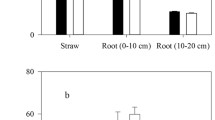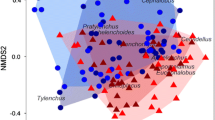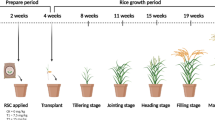Abstract
Insecticidal crystal (Cry) proteins produced by genetically modified rice that enter the soil via pollen dispersal, plant residues, and root exudation may disturb soil health. In the present study, we assessed the influences of transgenic Bt rice (i.e., HH1 with Cry1Ab/Cry1Ac) cultivation on the dynamics of soil carbon and nutrients under field conditions during 2013–2016. Transgenic treatments (transgenic Bt rice vs. its parental line (i.e., MH63) of non-Bt rice) have no consistently significant effects on soil property, including available nitrogen, available phosphorus, available potassium, total nitrogen, and total phosphorus, while apparent seasonal changes were observed. Besides, the variations of soil nutrients in the paddy field of transgenic Bt rice did not exceed their resistance capacities, except total organic carbon (TOC; RS (resistance) = 1.51) and total potassium (TK; RS = 2.62) in 2013 and TK (RS = 1.94) in 2014. However, the TOC and soil nutrient of TK in the paddy field of transgenic Bt rice have recovered to the pre-perturbation status after harvest (RL (resilience) = 1.01, F = 0.01, P = 0.91; RL = 0.98, F = 0.34, P = 0.58; RL = 0.99, F = 1.26, P = 0.29). Moreover, the paddy yield of transgenic Bt rice was consistently higher than that of its parental line of non-Bt rice. These results suggested that the cultivation of transgenic Bt rice has no adverse impact on soil stability in terms of soil carbon and nutrients and paddy yield.



Similar content being viewed by others
References
Bao SD (2000) Soil agricultural-chemical analysis. Agriculture Press, Beijing
Bates D, Maechler M, Bolker B (2012) Lme4: linear mixed-effects models using S4 classes
Bi YM, Kant S, Clark J, Gidda S, Ming F, Xu J, Rochon A, Shelp BJ, Hao L, Zhao R (2009) Increased nitrogen-use efficiency in transgenic rice plants over-expressing a nitrogen-responsive early nodulin gene identified from rice expression profiling. Plant Cell Environ 32:1749–1760
Brookes G, Barfoot P (2016) Environmental impacts of genetically modified (GM) crop use 1996-2014: impacts on pesticide use and carbon emissions. GM Crops Food 7(2):84–116
Čerevková A, Miklisová D, Szoboszlay M, Tebbe CC, Ľudovít C (2018) The responses of soil nematode communities to Bt maize cultivation at four field sites across europe. Soil Biol Biochem 119:194–202
Chen M, Shelton A, Ye GY (2011) Insect-resistant genetically modified rice in China: from research to commercialization. Annu Rev Entomol 56:81–101
Chen X, Liu T, Li X, Li H, Chen F, Liu M (2017) Soil nematode community varies between rice cultivars but is not affected by transgenic Bt rice expressing Cry1Ab, or Cry1Ab/Cry1Ac. Biol Fertil Soils 53(5):1–9
FAO (2013) Statistical yearbook 2013: World food and agriculture. Food and Agriculture Organization of the United Nations, Rome, p 289
Flores S, Saxena D, Stotzky G (2005) Transgenic Bt plants decompose less in soil than non-Bt plants. Soil Biol Biochem 37(6):1073–1082
Ghiberto PJ, Libardi PL, Brito AS, Trivelin PCO (2009) Leaching of nutrients from a sugarcane crop growing on an ultisol in Brazil. Agric Water Manag 96(10):0–1448
Guo W, Zhao Z, Su Y, Mou W, Liu M, Chen X, Chen F (2014) Effects of phytase tansgenic corn planting on soil nematode community. Chin J Appl Ecol 25(4):1107–1114
Jia HP (2010) Chinese green light for GM rice and maize prompts outcry. Nat Biotechnol 28(5):390–391
Li Y, Hallerman EM, Liu Q, Wu K, Peng Y (2016) The development and status of Bt rice in China. Plant Biotechnol J 14(3):839–848
Li Z, Wang B, Tian D, Wang J (2018) Bt rice cultivation does not cause soil biological degradation in terms of C, N, and P cycles. Land Degrad Dev:1–6
Liu T, Chen X, Qi L, Chen FJ, Liu MQ, Whalen JK (2018) Root and detritus of transgenic Bt crop did not change nematode abundance and community composition but enhanced trophic connections. Sci Total Environ 644:822–829
Lu C (2010) The first approved transgenic rice in China. GM Crops 1(3):113–115
Nakagawa S, Schielzeth H (2013) A general and simple method for obtaining R2 from generalized linear mixed-effects models. Methods Ecol Evol 4:133–142
Mandal A, Sarkar B, Owens G, Thakur JK, Manna MC, Niazi NK, Patra AK (2020) Impact of genetically modified crops on rhizosphere microorganisms and processes: a review focusing on Bt cotton. Appl Soil Ecol 148:103492
Mandal A, Thakur JK, Sahu A, Manna MC, Rao AS, Sarkar B, Patra AK (2019) Effect of Bt-cotton on biological properties of vertisols in Central India. Arch Agron Soil Sci 65:670–685
Quan R, Shang M, Zhang H, Zhao Y, Zhang J (2004) Engineering of enhanced glycine betaine synthesis improves drought tolerance in maize. Plant Biotechnol J 2:477–486
Romeis J, Naranjo SE, Meissle M, Shelton AM (2019) Genetically engineered crops help support conservation biological control. Biol Control 130:136–154
Sánchez-Pinillos M, Leduc A, Ameztegui A, Kneeshaw D, Lloret F, Coll L (2019) Resistance, resilience or change: post-disturbance dynamics of boreal forests after insect outbreaks. Ecosystems
Sarkar B, Patra AK, Purakayastha TJ, Megharaj M (2009) Assessment of biological and biochemical indicators in soil under transgenicbtand non-Bt cotton crop in a sub-tropical environment. Environ Monit Assess 156(1–4):595–604
Schroth G, Rodrigues MRL, D'Angelo SA (2000) Spatial patterns of nitrogen mineralization, fertilizer distribution and roots explain nitrate leaching from mature amazonian oil palm plantation. Soil Use Manag 16(3):222–229
Shu Y, Zhang Y, Zeng H, Zhang Y, Wang J (2017) Effects of Cry1Ab Bt maize straw return on bacterial community of earthworm Eisenia fetida. Chemosphere 173:1–13
Song Y, Liu R, Wang M, Liu M, Liu X, Ge F, Chen F (2019) Effects of transgenic Bt rice lines with single Cry1Ab and fused Cry1Ab/Cry1Ac on the abundance dynamics and community diversity of soil mites. Arch Agron Soil Sci
Strain KE, Lydy MJ (2015) The fate and transport of the Cry1Ab protein in an agricultural field and laboratory aquatic microcosms. Chemosphere 132:94–100
Tan F, Wang J, Feng Y, Chi G, Kong H, Qiu H (2010) Bt corn plants and their straw have no apparent impact on soil microbial communities. Plant Soil 329(1–2):349–364
Wang X, Xue Y, Han M, Bu Y, Liu C (2014) The ecological roles of Bacillus thuringiensis within phyllosphere environments. Chemosphere 108:258–264
Wang Y, Hu H, Huang J, Li J, Liu B, Zhang G (2013) Determination of the movement and persistence of Cry1Ab/1Ac protein released from Bt transgenic rice under field and hydroponic conditions. Soil Biol Biochem 58(2):107–114
Wei M, Tan F, Hong Z, Cheng K, Xiao W, Lingxi J, Tang X (2012) Impact of Bt-transgenic rice (SHK601) on soil ecosystems in the rhizosphere during crop development. Plant Soil Environ 58(5):217–223
Xiao M, Dong S, Li Z, Tang X, Song Z (2015) Effects of water management practices on residue decomposition and degradation of Cry1Ac protein from crop-wild Bt rice hybrids and parental lines during winter fallow season. Ecotoxicol Environ Saf 122:275–289
Xu Q, Dai R, Ruan Y, Rensing C, Liu M, Guo S, Shen Q (2018) Probing active microbes involved in Bt-containing rice straw decomposition. Appl Microbiol Biotechnol 102:10273
Yang W, Zhang M, Ding G (2012) Effect of transgenic Bt cotton on bioactivities and nutrients in rhizosphere soil. Commun Soil Sci Plant Anal 43(4):689–700
Yanni SF, Whalen JK, Ma BL (2011) Field-grown Bt and non-Bt corn: yield, chemical composition, and decomposability. Agron J 103(2):486–493
Zhaolei L, Naishun B, Jun C, Xueping C, Manqiu X, Feng W, Changming F (2017) Effects of long-term cultivation of transgenic Bt rice (kefeng-6) on soil microbial functioning and C cycling. Sci Rep UK 7(1):4647
Funding
This study was supported by the Special Program for New Transgenic Variety Breeding of the Ministry of Science and Technology, China (2016ZX08012005; 2012ZX08011002), the National Nature Science Foundations of China (NSFC) (31871963; 31272051), the Fundamental Research Funds for the Central Universities (KYZ201818), and the Qing-Lan Project of Jiangsu Province of China.
Author information
Authors and Affiliations
Corresponding author
Additional information
Responsible editor: Kitae Baek
Publisher’s note
Springer Nature remains neutral with regard to jurisdictional claims in published maps and institutional affiliations.
Rights and permissions
About this article
Cite this article
Song, Yy., Liu, Jw., Li, Lk. et al. Evaluating the effects of transgenic Bt rice cultivation on soil stability. Environ Sci Pollut Res 27, 17412–17419 (2020). https://doi.org/10.1007/s11356-020-08373-4
Received:
Accepted:
Published:
Issue Date:
DOI: https://doi.org/10.1007/s11356-020-08373-4




